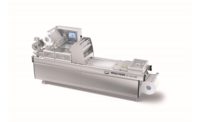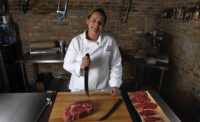Film Developments
By Sam Gazdziak, Senior Editor
Durability, shelf life and modified-atmosphere packaging are just a few reasons some processors turn to film.
Packaging of meat and poultry products needs to accomplish several things, including protecting the product inside and looking appealing to consumers. Many processors continue to choose film over other forms of packaging, as oxygen-sensitive meat products become more commonplace.
Creekstone Farms Premium Beef, based in Arkansas City, Kan., uses barrier film on its fresh sub-primal beef products. It also uses barrier film in its fully cooked items.
“We have a fully cooked meat operation here, and we primarily make deli meats for retail and foodservice,” says Kevin Pentz, senior vice president of operations.
Using packaging with film makes for a durable product, as well as helping to extend the shelf life for the retailers who stock the meat items.
“Appearance is also a factor, especially in the retail items that go right into a retail case, such as the MAP [modified-atmosphere packaging] ground beef and also our deli meat items,” Pentz says. Many of those areas are high-shrink environments, where a long shelf life is critical.
MAP quest
Film plays a key role in modified-atmosphere packaging, in which the air in the package is altered and locked inside the package by the film cap. In cases like that, barrier films are used to prevent the exchange of gases between the meat package and the atmosphere outside the package.
Creekstone Farms does MAP in both high-oxygen and low-oxygen environments. Pentz notes the advantage of using a low-oxygen package is that it maintains the brightness of the myoglobin in the meat, so the product will keep its color longer than a high-oxygen environment will.
“As long as the customer is rotating that out and paying attention to the actual use-by date that we’re putting on the package, it’s a very safe and desirable product for consumers,” he says. “They don’t have ground beef [that is] two or three days old turning colors. Once it’s on the shelf, it does maintain that color longer and is still very safe for the consumers.”
Low-oxygen packaging has run into issues, however, because of the use of carbon monoxide in the process. Claims have been made that using carbon monoxide covers up spoilage in the meat and poses a health risk to consumers.
“A major retailer decided not to use it,” Pentz notes, “which affected some of our accounts that decided to switch away and go back to the high-ox, which we believe is a detriment to the durability to the product. It has shown increased shrink at the retail levels because it doesn’t have the same shelf life as the low-ox environment does.”
Film costs
When it comes to packaging that meets customers’ requirements, Pentz says that film is the most cost-effective option. The company has ideas for future uses, including a retail steak-cutting operation, and it is waiting for the technology and equipment to get more cost-effective as well.
“I think as more companies get involved with retail packaging, I think there will be more viable solutions to get entry into that arena.”


Report Abusive Comment